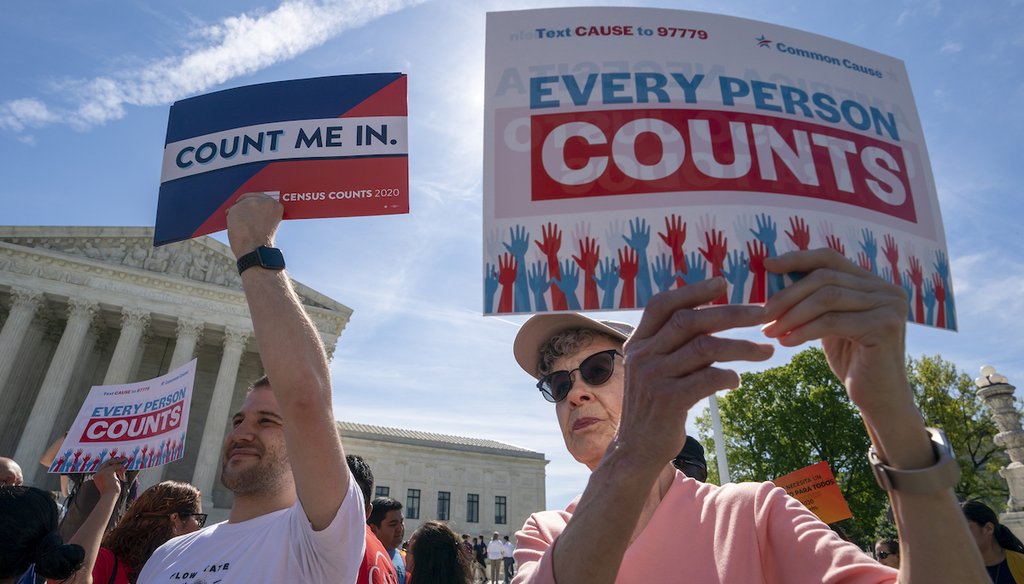Stand up for the facts!
Our only agenda is to publish the truth so you can be an informed participant in democracy.
We need your help.
I would like to contribute

Immigration activists rallied outside the U.S. Supreme Court on April 23, 2019, as the justices heard arguments over former President Donald Trump's plan to ask about citizenship on the 2020 census. (AP)
If Your Time is short
-
Two reports published before the 2020 census projected that not counting immigrants in the country illegally would basically have been a wash, with Democratic-led states and Republican-led states gaining and losing similar numbers of U.S. House seats.
-
More recent studies found that in recent years Republican-led states have experienced significant increases in immigrant populations, both legally and illegally in the country.
-
Our mission: Help you be an informed participant in democracy. Learn more.
High-profile people, Republican politicians and social media users are portraying increased immigration at the U.S. southern border as a Democratic plot to increase political power.
The claims hinge on the U.S. Census, which determines congressional seats and electoral votes, and counts everyone, citizens and noncitizens, including immigrants in the country illegally. The census has always counted this way; the U.S. Constitution specifies "counting the whole number of persons in each state."
"Most Americans are still unaware that the census counts ALL people, including illegal immigrants, for deciding how many House seats each state gets!" Elon Musk wrote March 7 on X, his social media platform. "This results in Dem states getting roughly 20 more House seats, which is another strong incentive for them not to deport illegals."
Congressional Republicans have introduced legislation that would bar the census from counting noncitizens, including those in the U.S. legally, such as green card holders. Former President Donald Trump tried, and failed, to do that.
"Democrats are exploiting the rights of U.S. citizens by encouraging illegal immigrants to enter the U.S., travel to sanctuary cities, and skew congressional redistricting for political gain," said Sen. Jim Risch, R-Idaho, one of the legislation sponsors, in a January news release.
Sign up for PolitiFact texts
Stephen Miller, who led the Trump administration’s immigration policy, said in March, "California would have half of the Electoral College votes it has right now but for illegal immigration."
Social media users amplified the claims. The speaker in a March 9 Instagram video said, "This is not an accident," pointing to a headline about a sharp rise in migration. The post’s caption noted that the census counts everybody and said, "The census counts ALL people — including illegal immigrants — when deciding how many House seats each state gets. Biden signed an executive order ensuring things stayed that way. This invasion is by design."
The rhetoric echoes the "great replacement theory," a baseless conspiracy theory that warns Democrats and world leaders are systematically trying to replace white people of European descent with nonwhite people.
We found no evidence that counting immigrants in the country illegally would give Democrats a significant advantage for congressional seats. Two reports published before the 2020 Census projected that not counting them would basically have been a wash, with Democratic-led states and Republican-led states gaining and losing similar numbers of U.S. House seats. More recent studies showed that immigrant populations, both here legally and illegally, have increased significantly in Republican-led states in recent years.
Here’s what we know about how immigrants in the country illegally affect political power in Congress.
House seats claims stem from outlier estimate of people here illegally
Musk cited no source for his claim that illegal immigration gives Democrats 20 more House seats. Other social media posts and conservative media articles said that immigrants in the U.S. illegally account for about 22 U.S. House seats.
The latter estimates are based on data from the Federation for American Immigration Reform, which advocates for reduced immigration. The federation says there are about 16.8 million immigrants in the country illegally as of June 2023. People making the 22 U.S. House seats claim divided the 16.8 million by 761,169, the number of people each congressional seat represents.
However, other immigration groups estimate a lower population of immigrants in the country illegally, ranging from 10.5 million to 11.35 million.
How census data is used for congressional apportionment, and who is counted
Each state is guaranteed one of the 435 House seats in the U.S. Congress, and the remaining 385 seats are divided among the 50 states based on the census count.
The current formula used for apportionment, called the Method of Equal Proportions, has been used since 1941. It’s based on a state’s population and aims to minimize the difference in representation among states.
The next census, in 2030, will be used to appropriate federal funding for public resources such as schools and roads and programs including Medicaid, determine 2033 congressional apportionment and allocate electoral votes for the presidency. Each state gets two electoral votes — equal to its number of senators — plus one vote for each of its representatives in Congress.
The U.S. Constitution’s 14th Amendment says the apportionment of representatives should be determined by counting the "whole number of persons in each state." The language does not make exceptions for people’s immigration status.
How many immigrants are in the U.S. illegally and where do they live?
Most groups estimate the number from 10 million to 11 million people. The Federation for American Immigration Reform’s estimate of 16.8 million is higher because the group’s methodology accounts for what it says is a 30% undercount of immigrants in the U.S. illegally.
The Center for Migration Studies, Pew, the Center for Immigration Studies and the Migration Policy Institute all factored in census undercounts when determining their most recent figures. The undercounts exist because numbers shift; migrants in the country illegally also leave, die or gain legal status.
The largest, most densely populated states, both Democratic- and Republican-led, have the highest number of immigrants in the country illegally.
The top six states have remained fairly consistent since at least 1990, Pew Research Center 2021 data shows: California, Texas, Florida, New York, New Jersey and Illinois. In 1990, those states were home to 80% of immigrants in the country illegally; in 2021, it was 56%.
"Immigrant populations are growing in other places where you have economic opportunity," said Yurij Rudensky, senior counsel for the Democracy Program at the left-leaning Brennan Center for Justice at the New York University School of Law. "There are immigrant populations in places like South Carolina and Tennessee and places where you see growth in manufacturing or other sorts of industry."
The Center for Migration Studies said in a January report that after a decade of decline, the number of unauthorized immigrants in the U.S. jumped by 650,000 in 2022. Florida had the largest increase with 125,000. Texas was next with 60,000, followed by New York (50,000), Maryland (45,000) and California (40,000).
A billboard in Dearborn, Michigan, encourages residents to take part in the 2020 census. The count determines congressional apportionment and federal funding for states and communities. (AP)
Does counting immigrants in the country illegally disproportionately benefit Democrats?
Studies from before and after the 2020 census don’t support the claim.
Two reports projecting what would happen if immigrants in the country illegally weren’t counted toward congressional apportionment in the 2020 Census show that neither Democrats nor Republicans would have gained a significant advantage:
-
A 2019 Center for Immigration Studies report showed three states would have lost one U.S House seat: Democratic-led California and New York, and Republican-led Texas. Three others would have gained a seat: Republican-led Alabama and Ohio, and Democratic-led Minnesota.
-
A 2020 Pew Research Center study reached a similar conclusion. California, Texas and Republican-led Florida would lose a seat, while Alabama, Ohio and Minnesota would have each gained one seat.
However, the Cato Institute, a libertarian think tank, said in a January 2024 report that the vast majority of the increase in noncitizen populations, both legal immigrants and immigrants in the country illegally, has gone to Republican-led states.
The report found that 95% of the increase in noncitizen populations from March 2019 to March 2023 has been in Republican-led states. Republican-led states gained 1,275,598 people, while Democratic-led states gained 71,973 people.
"The argument that recent immigration is boosting Democratic representation in Congress is unsubstantiated," wrote David Bier, the report’s author.
Experts we contacted provided mixed responses.
Steven Camarota, research director for the Center for Immigration Studies, which supports limited immigration, disputed that idea.
"It is hard to argue that immigration does not on balance help Democrats," Camarota said. He said immigrants and their children, once they obtain citizenship and the legal right to vote, typically have voted for Democrats, citing 2020 exit polls and a Pew analysis.
Camarota said the Census Bureau’s monthly Current Population Survey during the three years of Biden’s presidency shows the population of all immigrants growing the most in states that tend to be blue: California, Maryland, New Jersey and Virginia. That includes both legal immigrants and those in the country illegally.
Camarota pointed to a 2020 Center for Immigration Studies report that showed congressional districts with a higher percentage of noncitizens means that voters in those districts "have significantly more political power," because it takes fewer votes to win in a district with high numbers of noncitizens. The low-citizen-count districts are almost all represented by Democrats, he said.
No big advantage, other experts say
Robert Warren, a Center for Migration Studies researcher, said he conducted a simulation using 2016 data from the Census Bureau’s American Community Survey and the Center for Migration Studies, and found that if immigrants in the country illegally were included in a census count, California would gain two U.S. House seats, and New York and Texas would each gain one seat. Michigan, Minnesota, Montana and Pennsylvania would each lose a seat.
"I don’t see an advantage for either party based on these results," Warren said.
Jennifer Lynne Van Hook, a Penn State University sociology and demography professor, is skeptical of the claim that Democrats have 20 or more U.S. House seats because of illegal immigration.
By her calculations, immigrants in the country illegally are represented by about 14 House seats distributed across both red and blue states, with Republicans holding a slight advantage, eight seats versus the Democrats’ six. She said she didn’t look at the distribution of the immigrant population within each state.
Brian Gaines, a University of Illinois Urbana-Champaign political science professor, said Democrats likely would get a boost if the population of immigrants in the country illegally continues to rise before the next census. But he said the apportionment method doesn’t "systematically favor large or small states" and partisan redistricting in states is a factor, so it can be hard to forecast, he said.
Efforts to change census count
The last time the Census asked all households about citizenship was in 1950. From 1970 to 2000, about 1 in 6 households received a long-form census questionnaire that included a question on citizenship. The 2010 Census used only a 10-question short-form questionnaire that did not ask about citizenship.
Trump tried and failed in 2019 to require a citizenship question on the 2020 Census; his effort was blocked by the U.S. Supreme Court. Trump later issued executive orders seeking to compel the Census Bureau to obtain information about immigration status through other means, and to exclude immigrants in the country illegally from being counted for apportionment.
The Census Bureau abandoned efforts to provide a count of people here illegally to Trump near the end of his presidency. President Joe Biden, on his first day in office, signed an executive order reversing Trump’s executive orders.
U.S. Senate Republicans on March 8 failed to pass an amendment by Sen. Bill Hagerty, R-Tenn., to a spending package that would have required a citizenship question on the census and barred noncitizens, including immigrants in the country illegally, from being counted for congressional district and Electoral College apportionment, Fox News reported.
Hagerty also introduced a bill, the Equal Representation Act, in January that seeks the same outcome. It has been referred to the Committee on Homeland Security and Governmental Affairs. Rep. Chuck Edwards, R-N.C., introduced a House version of the bill in January.
Those bills, if passed, would exclude both immigrants in the country illegally and the estimated 12.7 million lawful permanent residents in the U.S from being counted.
Removing noncitizens from the Census Count would likely require a constitutional amendment, the Congressional Research Service wrote in 2015. Rudensky, of the Brennan Center for Justice, said these efforts "cut against both the text of the Constitution and now centuries of practice.
"Both citizens and noncitizens alike pay taxes, send kids to school, use roads, and while who votes is contingent on citizenship, everyone who is part of our community, everyone who is living and working within the U.S. gets represented."
Our Sources
Instagram post, March 9, 2024
Elon Musk, X post, March 7, 2024
X post, Feb. 15, 2024
Don Lemon, X post, March 18, 2024
Phone interview, Yurij Rudensky, senior counsel for the Democracy Program at the Brennan Center for Justice at the New York University School of Law, March 14, 2024
Email interview, Steven Camarota, the director of research for the Center for Immigration Studies, March 15, 2024
Email interview, Robert Warren, researcher at the Center for Migration Studies, March 14, 2024
Email interview, Jennifer Lynne Van Hook, a Penn State University sociology and demography professor, March 14, 2024
Email interview, Brian Gaines, a University of Illinois Urbana-Champaign political science professor, March 13, 2024
Migration Policy Institute, Profile of the Unauthorized Population: United States, accessed March 14, 2024
Migration Policy Institute, Unauthorized Immigrant Population Profiles, accessed March 14, 2024
Pew Research Center, What we know about unauthorized immigrants living in the U.S., Nov. 16, 2023
Pew Research Center, How removing unauthorized immigrants from census statistics could affect House reapportionment, July 24, 2020
Pew Research Center, Key facts about the changing U.S. unauthorized immigrant population, April 13, 2021
Pew Research Center, Measuring illegal immigration: How Pew Research Center counts unauthorized immigrants in the U.S., July 12, 2019
Pew Research Center, Party affiliation among immigrants by state, accessed March 21, 2024
Center for Migration Studies, After a Decade of Decline, the US Undocumented Population Increased by 650,000 in 2022, Jan. 28, 2024
Center for Migration Studies, Sage Journals After a Decade of Decline, the US Undocumented Population Increased by 650,000 in 2022, Jan. 28, 2024
Cato Institute, Apportionment & Immigration: 95 Percent of Noncitizen Growth Went to GOP States Since 2019, Jan. 24, 2024
Center for Immigration Studies, The Impact of Legal and Illegal Immigration on the Apportionment of Seats in the U.S. House of Representatives in 2020, Dec. 19, 2019
Center for Immigration Studies, The Impact of Non-Citizens on Political Representation in the House of Representatives, Feb. 13, 2020
Center for Immigration Studies, Estimating the Illegal Immigrant Population Using the Current Population Survey, March 29, 2022
Center for Immigration Studies, Republican establishment swallows the Democrat Line on Immigration Reform - Hook, Line, and Sinker, Aug. 13, 2013
CNN, 2020 exit polls, accessed March 21, 2024
Eagle Forum, How Mass (Legal) Immigration Dooms a Conservative Republican Party, June 2014
U.S. Census Bureau, Historical Perspective, accessed March 18, 2024
U.S. Census Bureau, Frequently Asked Questions, accessed March 18, 2024
U.S. Census Bureau, Congressional Apportionment, accessed March 18, 2024
U.S. Census Bureau, How Apportionment is Calculated, April 26, 2021
U.S. Census Bureau, What is Apportionment?, April 26, 2021
U.S. Census Bureau, Why We Conduct the Decennial Census of Population and Housing, accessed March 20, 2024
National Archives, Distribution of Electoral Votes, accessed March 19, 2024
Federation for Immigration Reform, Biden border crisis and abuse of parole send illegal alien population and costs soaring, June 22, 2023
National Archives, Collecting information about citizenship status in connection with the decennial Census, July 16, 2019
National Archives, Memorandum on excluding illegal aliens from the apportionment base following the 2020 Census, July 21, 2020
The Washington Post, Census Bureau says it will stop trying to deliver tally of undocumented to Trump, Jan. 14, 2021
The Washington Post, The audacious timeline of Trump’s failed plot on the census and citizenship, Jan. 18, 2022
The Washington Post, Census Bureau says it will stop trying to deliver tally of undocumented to Trump, Jan. 14, 2021
NPR, Biden ends trump Census policy, ensuring all persons living in U.S. are counted, Jan. 20, 2021
The White House, Executive order on ensuring a lawful and accurate enumeration and apportionment prsuant to the Decennial census, Jan. 20, 2021
Cornell Law School, 14th Amendment, accessed March 18, 2024
Congress, H.R.7109 - Equal Representation Act, accessed March 18, 2024
Congress, S.3659 - Equal Representation Act, accessed March 18, 2024
Fox News, GOP effort to stop illegal immigrants being counted for House districts, Electoral College shot down in Senate, March 9, 2024
Fox News, Illegal immigration could have major impact on House seats, Electoral College: experts, Feb. 15, 2024
New York Post, Republicans sound alarm on migrants ‘influencing’ electoral map, Feb. 15, 2024
PolitiFact, What you need to know about the Census’ citizenship question, March 28, 2018
PolitiFact, Fact-checking a claim about immigrants and California’s 'extra' House seats Aug. 6, 2020
Congressional Research Service, Apportioning seats in the U.S. House of Representatives Using the 2013 estimated citizen population, Oct. 30, 2015
Department of Homeland Security, Estimates of the Lawful Permanent Resident Population in the United States and the Subpopulation Eligible to Naturalize: 2023, October 2023








































